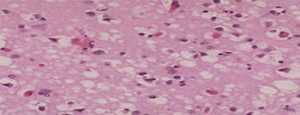
21 Oct Surveillance for Human Prion Disease
MedicalResearch.com Interview with:
Liliana Sanchez-Gonzalez MD, MPH
Medical Epidemiologist
Dengue Branch – Division of Vector Borne Diseases
Centers for Disease Control and Prevention
San Juan, PR
MedicalResearch.com: What is the background for this study? Would you briefly explain the significance of prion disease?
Response: Prion diseases are neurodegenerative diseases that occur in animals and humans. These diseases are caused by an infectious agent known as a prion. While the accuracy of diagnostic tests using cerebrospinal fluid or brain imaging from living patients has improved greatly in recent years, analysis of brain tissue is still necessary to confirm the diagnosis of these diseases.

This tissue slide shows sponge-like lesions in the brain tissue of a classic CJD patient.
Human prion disease cases are rare, but always fatal. There have been around 500 reported cases annually in the US in recent years. A very small percentage of human prion disease cases are acquired, meaning they are caused by an exposure to the infectious agent from an external source. The most well-known acquired human prion disease is variant Creutzfeldt-Jakob disease (vCJD), which was first described in the United Kingdom in 1996 and linked to consumption of contaminated beef from cattle with the animal prion disease bovine spongiform encephalopathy (BSE, or “mad cow” disease).
The only US state where classic BSE has been reported is Washington, where an infected dairy cow was imported from Canada in 2003. Beef from the slaughtered cow was processed for human consumption, and beef from cattle slaughtered the same day at the involved slaughter plant was recalled. After this incident, the Washington State Department of Health, in collaboration with the US Centers for Disease Control and Prevention and the National Prion Disease Pathology Surveillance Center (NPDPSC), implemented enhanced human prion disease surveillance. All patients with positive results from tests conducted at the NPDPSC are investigated. We present the results of 12 years of human prion disease surveillance, from 2006 to 2017, plus results of surveillance for vCJD through July 2020.
MedicalResearch.com: What are the main findings?
Response: No cases of variant Creutzfeldt-Jakob disease were identified in Washington during the surveillance period. A total of 143 human prion disease cases were detected, the majority of them confirmed through brain tissue analyses. The average annual age-adjusted incidence was 1.5 cases per million population, with no significant difference in incidence between males and females. The highest annual age-specific incidence rate was found in the 75 to 84-year-old age group.
MedicalResearch.com: What should readers take away from your report?
Response: Characteristics for prion disease patients in Washington were consistent with national findings. The state’s human prion disease incidence during 2006-2017 was slightly higher than what has been reported for the United States as a whole. This may be due to the state’s enhanced surveillance activities, including close collaboration with key partners and educational efforts targeted toward healthcare providers. These enhanced surveillance activities, which did not result in the identification of a single vCJD case, provide strong evidence against the presence of this acquired prion disease in the one US state where a classic case of BSE was identified. Surveillance for human prion diseases in Washington is beneficial for monitoring epidemiological trends, facilitating accurate diagnoses, and detecting vCJD or other emerging human prion diseases should they occur.
MedicalResearch.com: What recommendations do you have for future research as a result of this work?
Response: Ongoing human prion disease surveillance is critical to detect possible cases of vCJD and other acquired forms of prion disease in the United States. Early detection of such cases would allow public health professionals to investigate the source of infection and implement appropriate control measures.
MedicalResearch.com: Is there anything else you would like to add?
Response: For more information on prion diseases, please visit the CDC website: https://www.cdc.gov/prions/index.html
The CJD Foundation is an excellent resource for patients and families affected by CJD: https://cjdfoundation.org/
More information on the diagnostic services provided by the National Prion Disease Pathology Surveillance Center is available through the NPDPSC website: https://cjdsurveillance.com
Any disclosures?
Our findings and conclusions do not necessarily represent the official position of the Centers for Disease Control and Prevention.
Citation:
Sánchez-González L, Maddox RA, Lewis LC, et al. Human Prion Disease Surveillance in Washington State, 2006-2017. JAMA Netw Open. 2020;3(10):e2020690. doi:10.1001/jamanetworkopen.2020.20690
[subscribe]
Last Modified: [last-modified]
The information on MedicalResearch.com is provided for educational purposes only, and is in no way intended to diagnose, cure, or treat any medical or other condition. Always seek the advice of your physician or other qualified health and ask your doctor any questions you may have regarding a medical condition. In addition to all other limitations and disclaimers in this agreement, service provider and its third party providers disclaim any liability or loss in connection with the content provided on this website.
Last Updated on October 21, 2020 by Marie Benz MD FAAD
